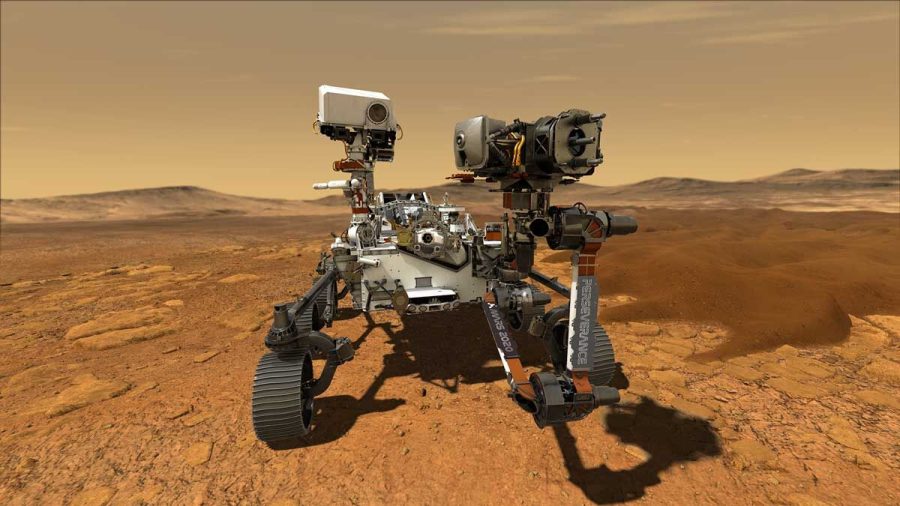NASA’s Fifth Rover Successfully Lands on Mars
Courtesy of The National Aeronautics and Space Administration
On Feb. 18, NASA’s fifth rover, Perseverance, successfully landed on Mars after traveling 300 million miles through the vacuum of space.
March 3, 2021
Amidst a global pandemic, the National Aeronautics and Space Administration (NASA) and its engineers have still managed to drop jaws around the world. On Feb. 18, NASA’s fifth rover, Perseverance, successfully landed on Mars after traveling 300 million miles through the vacuum of space. Its tasks are to search for signs of past life, collect rock and soil samples and gather the information that will help NASA prepare for future human exploration.
After years of manufacturing and costing nearly $2.4 billion, Perseverance began its six and a half month journey to the Red Planet. At 7:50 a.m. EST on July 30, 2020, on the Cape Canaveral Air Force Base in Florida, NASA launched an Atlas V-541 rocket carrying the rover.
“This is the same type of rocket that launched the Insight and Curiosity rovers to Mars,” NASA said.
After reaching its top speed of 24,600 mph about 50 minutes into the flight, the rocket’s spacecraft detached. From then on, trained engineers made flight adjustments using eight thrusters attached on its sides to ensure it would stay on the projected flight path. This allowed it to arrive at its proper landing zone on Mars: the Jezero Crater. The river delta near this site suggests it may have been home to a large body of water. If so, rich clays can be collected here and tested for evidence of ancient life. Engineers made the first flight path adjustment just 15 days after the launch. Meanwhile, they repeatedly checked its health and maintenance, then prepared it for entry, descent and landing in the last 45 days of the trip.
Most of the landings on Mars attempted by other space programs have been unsuccessful due to unexpected mishaps or equipment malfunctions. Everything must go as planned, or it could ruin a long-anticipated mission. Furthermore, Perseverance landed with no human aid, making things more challenging and impressive.
The landing sequence began with final preparations, which included separating from the cruise stage (the module used to store the rover) to a casing that protected another part of the spacecraft during its entry called the aeroshell. This time, the vehicle itself used thrusters to position the heat shield towards the approaching atmosphere. Once oriented, friction from the surrounding air heated the aeroshell’s belly to about 2,400 degrees Fahrenheit.
“Safe in the aeroshell, however, the rover gets up to only about room temperature,” NASA said.
Again, it used thrusters for stabilization during the shaky entrance.
As the friction slowed the spacecraft down to about 1,000 mph, a large parachute with a 70.5-foot diameter was deployed. Thanks to technology crafted by the engineers, the capsule used a “Range Trigger” to help determine when to release the parachute and rid itself of the heat shield and shell without command from Earth. Once the parachute was cut loose, all that remained was the Perseverance rover and an apparatus called the descent stage that contains the last set of thrusters. Using radars, cameras and sensors, the descent stage mechanism picked out a safe and appropriate landing site near the Jezero Crater. When it had located a spot, the vehicle hovered at about 7,000 feet, then slowly lowered the rover at two miles per hour and initiated the drop-off sequence using a “skycrane.” While it dropped the rover with a 21-foot cable, the mobility systems were turned on. Finally, sensors on its undercarriage detected the planet’s surface, and the wires were cut. The hovering descent stage was then programmed to fly away and land safely somewhere else. While this was all occurring, there were about 10 minutes of no radio contact proving it had touched down autonomously. Once radio contact returned, videos of its descent were sent back to the operation center on Earth, providing more proof of a successful landing. NASA eventually released these to the public.
In addition to the pictures of the reddish-orange landscape, microphones helped transmit the first-ever audio of Mars’ sounds back to Earth. The recording contained the sounds of wind, masked by faint feedback from the microphones. Though it was not much, these astonishing sounds have already prompted so many questions about Mars.
As the rover begins to roam, it will start a series of scientific studies known as “Surface Operations.” During this time, Perseverance will do several things. It will find rocks that formed in or were changed by environments that could have supported life. It will test the ability to produce oxygen from the carbon-dioxide atmosphere in support of future human missions. It will drill holes to collect samples from rock and soil targets and store them. Once the rover has completed its tasks, it will find a secure place to set down the specimens, which will be retrieved in future missions.
Speculations of a human mission to Mars have flooded the internet for years, especially after the recent rover landing. There are rumors that billionaire Elon Musk and his company, SpaceX, will try to beat NASA to Mars in the coming years and decades. But for now, we must be patient for another “one small step for man, one giant leap for mankind” moment and focus on the current mission, its future discoveries and how it will help today’s science.











